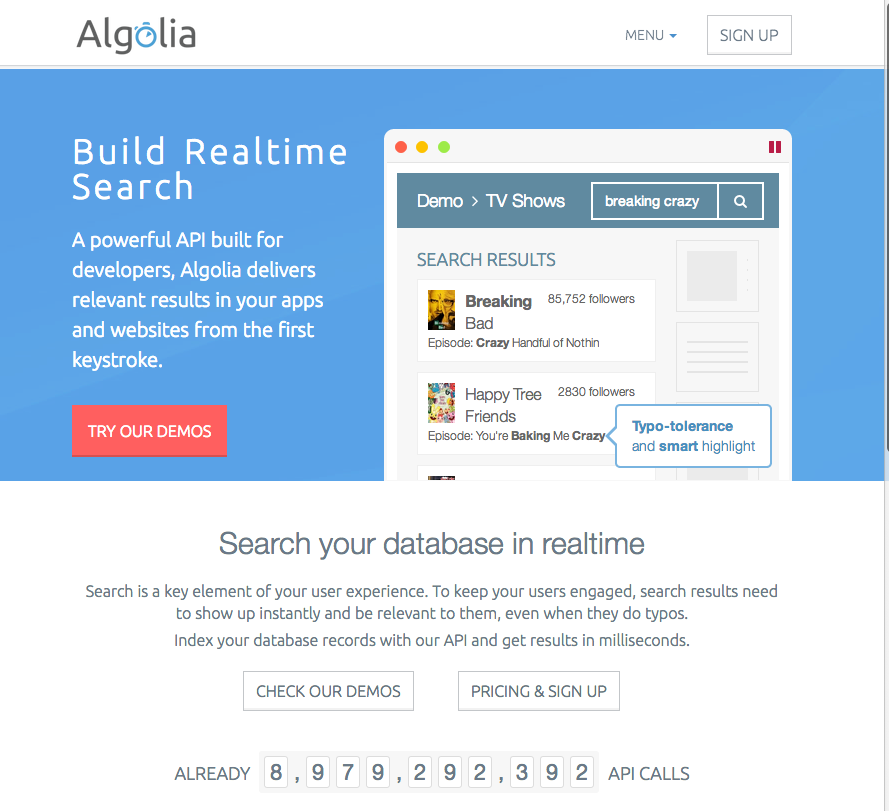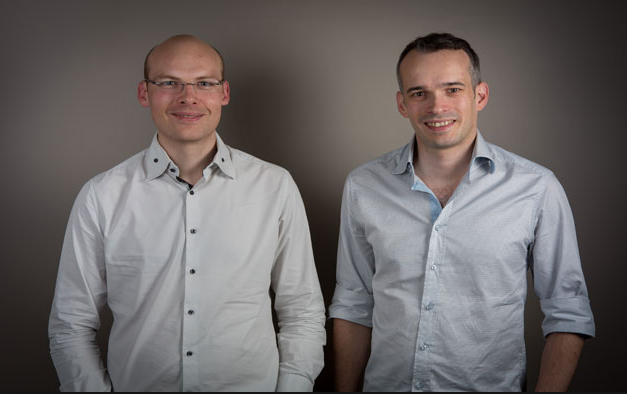I wrote the post below in 2014 when Algolia was at $10k a month in MRR. Today, they are at $200m+ ARR. Interesting to look back in time here — Jason, ed. January 2024
….
Much of SaaStr involves sharing my learnings, mistakes, improvements, etc. as a founder CEO that lived the journey from $0 to $100m in ARR. But do I practice what I preach? I hope so. Let’s take a look together. Recently, I was fortunate enough to invest what I believe is an outstanding SaaS company and service, Algolia.
 Algolia provides search-as-a-service. Their goal is to become “the search layer of the internet”. If you want to add search to your app, instead of building it yourself on top of software on servers you have to deploy and manage … you can just add Algolia and deploy in a day. Not only that, for a subset of search that involves “small documents” or objects, like searching on Crunchbase for companies (an Algolia customer), Hackernews for news (an Algolia customer), search for e-commerce, or movies, or the like … Algolia can be 10x-30x or more faster than the competition.
Algolia provides search-as-a-service. Their goal is to become “the search layer of the internet”. If you want to add search to your app, instead of building it yourself on top of software on servers you have to deploy and manage … you can just add Algolia and deploy in a day. Not only that, for a subset of search that involves “small documents” or objects, like searching on Crunchbase for companies (an Algolia customer), Hackernews for news (an Algolia customer), search for e-commerce, or movies, or the like … Algolia can be 10x-30x or more faster than the competition.
Ok so that’s what it does. And that’s cool. At EchoSign, we spent 3 months building this on top of Lucene. And we had to maintain it (big pain). One day and zero maintenance would have been a lot better. Everything should and will be a service. Try it yourself here on Crunchbase.
And the team is very strong. They were heads of R&D at Exalead, a leading French search company acquired for over $200m. So they know search. But … that’s tablestakes. Why would anyone invest in a poor team? No one would. Ok so the product is strong and differentiated, it’s SaaS, and the team is strong.
But that’s not what attracted me to the investment. Here are the SaaStr themes that did:
1. Tilting A Smidge Upmarket. Algolia started off with price points as low as $19 a month. While Algolia is still very cheap for basic usage, they quickly learned how to accommodate larger and larger customers and deal sizes as well. To target both the long tail of individual and smaller developer accounts — but also the needs of larger enterprise accounts as well. Three-figure deals are great if you have a lot of them, but add six-figure deals into the mix, and that’s the fastest way to $10m in ARR. I love products and companies that can move just a smidge upmarket, and dramatically improve their average unit economics. It doesn’t take much tilting upmarket to have a huge impact. I knew from experience Aloglia could pull this off. And they already have.
>> More on Tilting a Smidge Upmarket here and here.
2. Lead Velocity. Algolia doesn’t have huge lead velocity yet — they can’t. Because they’ve really only been in the market for less than a year. That’s not enough time for a true mini-brand to develop, or for second-order revenue to become material. But they’ve already crossed 200+ paying customers, many of relatively large deal sizes. The leads — a combination of organic inbound, and outbound developed — are growing fast enough to support a relatively rapid path to $10m+ in ARR. Without it, this early lead velocity, I would pass. But with the lead velocity, it was easy for me to draw a relatively quick line to $10m in ARR … even back when the company was just at $10k MRR.
Now in the early days, Lead Velocity isn’t a perfect metric. It’s too early. But seeing enough growth to fuel the aspirations of the business model instills confidence. Add a great revenue team to solid lead velocity — then magic happens.
> More on Lead Velocity here.
3. Commitment to Real Sales, As Well As Happiness Officers. The Algolia founders are not classically trained in sales, but I love that they quickly grew to be students of how to scale not just their application, but revenue as well. From Day 1 they committed to sales, and sales processes, and doing whatever it takes to make enterprise customers successful. Happiness Officers alone are great. But you need real sales processes to close deals of a real size.
>> More on the Curse of ‘Middlers’ and Happiness Officers here.
4. A Large but Nonobvious TAM. Is search-as-a-service really a billion dollar market? You could argue otherwise. Today it ain’t. It’s a few million a year market 😉 But what I’ve learned is market size in SaaS is what you make of it. What matters is if you can hit $100m ARR in 7 years, not what it is today. Algolia is on a path to hit millions in revenue this year, its first year as a commercial product. Once you hit millions, well then … of course you can get to $10 million. And from $10 million … it’s just one order of magnitude to $100m and an IPO. So yeah search-as-a-service is a terribly small market today, measured in terms of its current market size. It’s nascent and tiny. But the revenue growth and lead velocity is there. It will be a $X00m market in 7-8 years. The math proves it. That’s all that matters in TAM and SaaS. Your growth defines your TAM. Your TAM doesn’t define your growth. Not unless you are just replacing one commodity with another, which isn’t what we’re all doing.
>> More on TAM and $100m in ARR here, and why you don’t really know if your market is too small for quite a while here.

5. Extreme Commitment. I was impressed that the founders understood that they were committing to a 7-10 year journey, and what that meant. There are no Instagrams in SaaS. It compounds. It takes time to get the engine going, but once it goes — and it takes years — it becomes unstoppable. The founders were committed to moving themselves and their families from Paris to the U.S. to make it happen. To move from mobile to browser-based search. To serve the needs of both individual developers and large enterprises. To do what it takes not just this year or next, but across the whole journey.
A great team in an exciting, emerging market with a long-term commitment — I’ll take that bet. But unless the whole team has the long-term commitment, in SaaS at least — I have to take a pass.
>> More on the 7-10 Year Founder Commitment here, the 7-10 Year Sales Cycle here, and how SaaS compounds here.
The power of compounding revenue is that it compounds. The challenge is that it’s a lot of hard work and elbow grease to get it there. Algolia has 250 customers now, real in-bound interest, good unit economics — and will have a mini-brand by the end of the year. I’ll take that bet any day. It’s money where the SaaStr mouth is.

